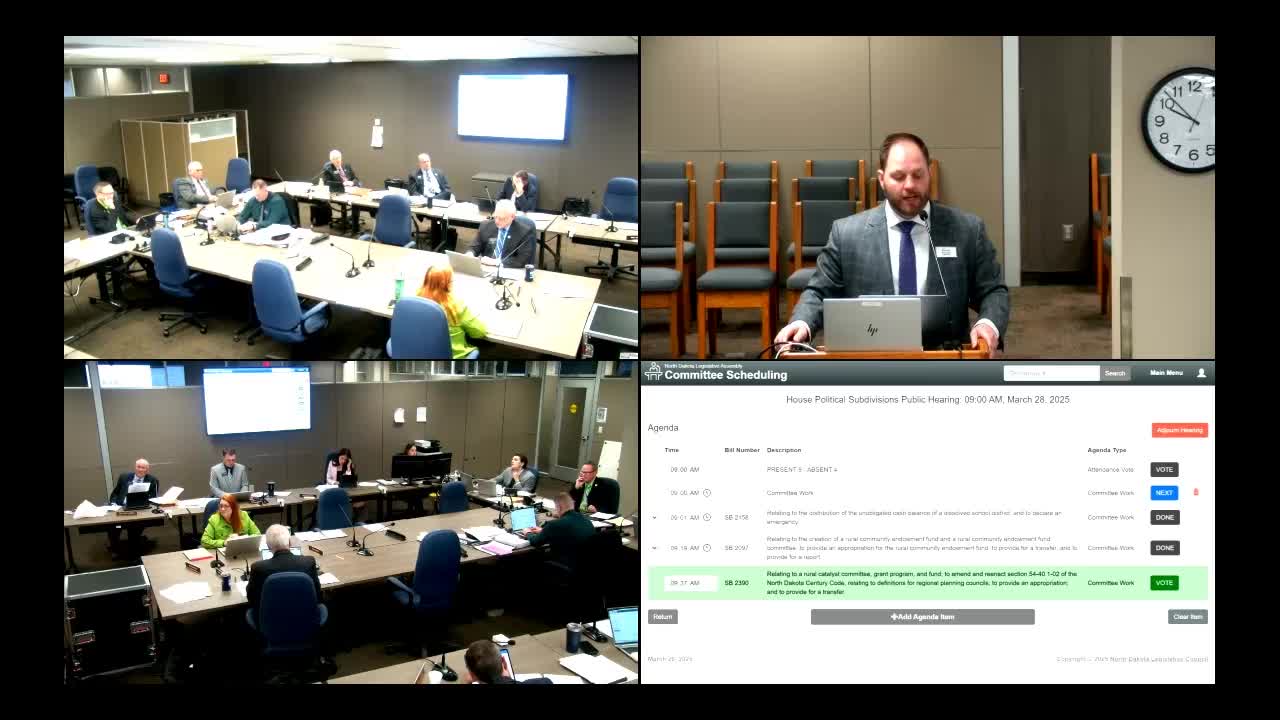Senate Bill 2390 aims to boost rural community development in North Dakota
March 28, 2025 | Political Subdivisions, House of Representatives, Legislative, North Dakota
This article was created by AI summarizing key points discussed. AI makes mistakes, so for full details and context, please refer to the video of the full meeting. Please report any errors so we can fix them. Report an error »

The North Dakota Legislature convened on March 28, 2025, to discuss Senate Bill 2390, aimed at providing financial support to rural communities for quality of life and economic development projects. The bill seeks to address the unique challenges faced by smaller communities that often lack the capacity to initiate critical projects and may have needs that are not met by existing funding programs.
The primary distinction between Senate Bill 2390 and Senate Bill 2097 was highlighted during the meeting. While Senate Bill 2097 proposes the creation of an endowment fund that requires $5 million in private investment before any distributions can occur, Senate Bill 2390 offers immediate funding support. The proposed funding includes a total of $10 million, with $5 million allocated from the State Investment Fund (SIF) and an additional one-time funding of $5 million.
Discussions also focused on the rationale behind adjusting the funding thresholds for community projects. The committee considered the impact of lowering the threshold from $8,500 to $4,500, which would allow more communities to access funds. However, concerns were raised about potential duplication of existing programs, such as the Prairie Dog Fund, which has already provided significant infrastructure support to rural areas.
Proponents of Senate Bill 2390 argued that it addresses quality of life improvements and economic development needs that are not fully covered by existing resources. They emphasized the importance of supporting unique community initiatives, such as maintaining local grocery stores and enhancing community facilities, which are vital for sustaining economic activity and community engagement.
The bill is set to move to the Appropriations Committee for further consideration, with stakeholders committed to ensuring that it does not duplicate efforts already underway in other legislative initiatives. The discussions underscored the interconnectedness of quality of life and economic development, with the bill aiming to foster both aspects in rural communities across North Dakota.
The primary distinction between Senate Bill 2390 and Senate Bill 2097 was highlighted during the meeting. While Senate Bill 2097 proposes the creation of an endowment fund that requires $5 million in private investment before any distributions can occur, Senate Bill 2390 offers immediate funding support. The proposed funding includes a total of $10 million, with $5 million allocated from the State Investment Fund (SIF) and an additional one-time funding of $5 million.
Discussions also focused on the rationale behind adjusting the funding thresholds for community projects. The committee considered the impact of lowering the threshold from $8,500 to $4,500, which would allow more communities to access funds. However, concerns were raised about potential duplication of existing programs, such as the Prairie Dog Fund, which has already provided significant infrastructure support to rural areas.
Proponents of Senate Bill 2390 argued that it addresses quality of life improvements and economic development needs that are not fully covered by existing resources. They emphasized the importance of supporting unique community initiatives, such as maintaining local grocery stores and enhancing community facilities, which are vital for sustaining economic activity and community engagement.
The bill is set to move to the Appropriations Committee for further consideration, with stakeholders committed to ensuring that it does not duplicate efforts already underway in other legislative initiatives. The discussions underscored the interconnectedness of quality of life and economic development, with the bill aiming to foster both aspects in rural communities across North Dakota.
View full meeting
This article is based on a recent meeting—watch the full video and explore the complete transcript for deeper insights into the discussion.
View full meeting
